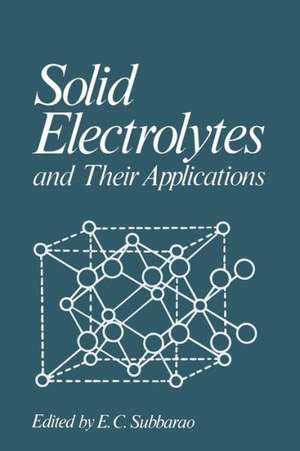Solid Electrolytes and Their Applications
Editat de E. Subbaraoen Limba Engleză Paperback – 6 oct 2011
Preț: 640.55 lei
Preț vechi: 753.60 lei
-15% Nou
Puncte Express: 961
Preț estimativ în valută:
122.57€ • 128.31$ • 101.42£
122.57€ • 128.31$ • 101.42£
Carte tipărită la comandă
Livrare economică 07-21 aprilie
Preluare comenzi: 021 569.72.76
Specificații
ISBN-13: 9781461330837
ISBN-10: 1461330831
Pagini: 316
Ilustrații: XVI, 298 p.
Dimensiuni: 152 x 229 x 17 mm
Greutate: 0.42 kg
Ediția:Softcover reprint of the original 1st ed. 1980
Editura: Springer Us
Colecția Springer
Locul publicării:New York, NY, United States
ISBN-10: 1461330831
Pagini: 316
Ilustrații: XVI, 298 p.
Dimensiuni: 152 x 229 x 17 mm
Greutate: 0.42 kg
Ediția:Softcover reprint of the original 1st ed. 1980
Editura: Springer Us
Colecția Springer
Locul publicării:New York, NY, United States
Public țintă
ResearchCuprins
1. Defect Structure and Transport Properties.- 1. Introduction.- 2. Defect Structure.- 3. Experimental Methods.- 4. Materials.- 5. Concluding Remarks.- References.- 2. Limiting Factors in Measurements Using Solid Electrolytes.- 1. Introduction.- 2. Electronic Conduction in the Electrolyte.- 3. Maintaining a Desired Chemical Potential at the Electrode-Electrolyte Interface.- 4. Effects of Porosity, Inhomogeneity, and Inadequate Mechanical Properties.- 5. Experimental Uncertainties.- 6. Concluding Remarks.- References.- 3. Thermodynamic Studies of Alloys and Intermetallic Compounds.- 1. Introduction.- 2. Metallic Alloy Systems.- 3. Oxygen Dissolved in Metals and Alloys.- 4. Fluoride Cells to Study Carbides, Borides, Phosphides, and Sulfides.- 5. Conclusion.- References.- 4. Thermodynamic Properties of Oxide Systems.- 1. Introduction.- 2. Comparison of the Solid Electrolyte Method with Other Methods for Thermodynamic Measurements.- 3. Types of Solid Electrolytes Used in the Study of Oxide Systems.- 4. Thermodynamic Measurements of Oxide Systems with Cells Involving Oxide Solid Electrolytes.- 5. Thermodynamic Measurements of Oxide Systems with Cells Involving Fluoride Solid Electrolytes.- 6. Concluding Remarks.- References.- 5. Kinetic Studies.- 1. Introduction.- 2. Polarization Studies.- 3. Diffusion Measurements.- 4. Kinetics of Phase-Boundary and Diffusion-Controlled Reactions.- 5. Concluding Remarks.- References.- 6. Technological Applications of Solid Electrolytes.- 1. General.- 2. Oxygen Meters.- 3. Oxygen Transfer to and from Materials.- 4. Energy Conversion.- 5. Batteries with ?-Alumina Electrolytes.- 6. Solid State Ionics.- References.- 7. Fabrication.- 1. Introduction.- 2. Single Crystals.- 3. Polycrystalline Materials.- 4. Electrodes.- 5. Joining of Materials.-6. Conclusions.- References.












